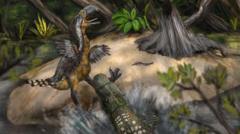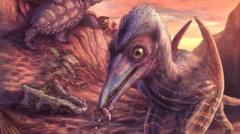A remarkable study published in Biology Letters has unveiled evidence pointing towards a deadly encounter between a terror bird and a colossal caiman that took place 13 million years ago. The analysis of teeth marks on the fossilized leg bone of a terror bird indicates that this fearsome creature, which could reach heights of over 2.5 meters, did not survive its encounter with the prehistoric predator.
Researchers from Colombia, using 3D digital scans, matched the distinct teeth marks on the fossil to those of an extinct caiman known as Purussaurus neivensis, which could grow up to five meters in length. This investigation not only elucidates the ancient predatory hierarchy but also provides a rare glimpse into the interactions between two apex predators during the Middle Miocene epoch.
Lead researcher Andres Link from the Universidad de Los Andes emphasized the significance of the findings, explaining that the absence of healing indicators in the bite marks suggests the terror bird either succumbed to its injuries during the attack or was scavenged afterward. Highlighting the value of fossils, he remarked, "Every piece of a body helps us to understand so much about life on the planet in the past."
The leg bone, first discovered over 15 years ago in Colombia's Tatacoa Desert by fossil collector César Augusto Perdomo, has since undergone extensive analysis by scientists. This area is known for its rich fossil deposits, which formed under humid, swampy conditions that favored the preservation of ancient creatures.
As researchers continue to piece together the story of life that flourished in this region, the new findings challenge previous assumptions about the vulnerability of terror birds, revealing that they were not as invulnerable to predation as once thought. This revelation provides a fascinating insight into the dynamics of ancient ecosystems and the relationships between different species in a time long gone.

















